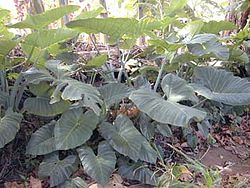Callaloo: Difference between revisions
No edit summary |
|||
| Line 17: | Line 17: | ||
Callaloo in Trinidad and other eastern Caribbean countries is generally made with [[okra]] and dasheen or water spinach ''Ipomoea aquatica''. There are many variations of callaloo which may include [[coconut milk]], [[crab]], [[conch]], [[spiny lobster|Caribbean lobster]], [[meat]]s, [[chili pepper]]s, and other [[seasoning]]s such as chopped onions and garlic. The ingredients are added and simmered down to a somewhat stewlike consistency. When done, callaloo is dark green in color and is served as a side dish which may be used as a gravy for other food. |
Callaloo in Trinidad and other eastern Caribbean countries is generally made with [[okra]] and dasheen or water spinach ''Ipomoea aquatica''. There are many variations of callaloo which may include [[coconut milk]], [[crab]], [[conch]], [[spiny lobster|Caribbean lobster]], [[meat]]s, [[chili pepper]]s, and other [[seasoning]]s such as chopped onions and garlic. The ingredients are added and simmered down to a somewhat stewlike consistency. When done, callaloo is dark green in color and is served as a side dish which may be used as a gravy for other food. |
||
Callaloo is widely known throughout the Caribbean and has a distinctively Caribbean origin, created by enslaved [[African]]s using ideas of the indigenous people along with both African (okra) and indigenous (''Xanthosoma'') plants (See [[Palaver Sauce]] for the West African dish). Trinidadians have embraced this dish from their ancestors and over time have added ingredients such as coconut milk to modify its flavor. Callaloo is mostly served as a side dish, for Trinidadians, Bajans, and Grenadians it usually accompanies rice, macaroni pie, and a meat of choice. |
Callaloo is widely known throughout the Caribbean and has a distinctively Caribbean origin, created by enslaved [[African]]s using ideas of the indigenous people along with both African (okra) and indigenous (''Xanthosoma'') plants (See [[Palaver Sauce]] for the West African dish). Trinidadians have embraced this dish from their ancestors and over time have added ingredients such as coconut milk to modify its flavor. Callaloo is mostly served as a side dish, for Trinidadians, Bajans, and Grenadians it usually accompanies rice, macaroni pie, and a meat of choice. In Guyana it is made in various ways without okra, and with overseas Guyanese it now seems to be termed Baji, the Guyanese Indian term for spinach. |
||
In the Virgin Islands, callaloo is served with a dish of [[fungee]] on the side. |
In the Virgin Islands, callaloo is served with a dish of [[fungee]] on the side. |
||
Revision as of 20:29, 17 June 2011

Callaloo (sometimes calaloo or kallaloo) is a popular Caribbean dish served in different variants in across the Caribbean. The main ingredient is a leaf vegetable, traditionally either amaranth (known by many local names including callaloo or bhaaji), taro or Xanthosoma. Both are known by many names including callaloo, coco, tannia, bhaaji, or dasheen bush. Because the leaf vegetable used in some regions may be locally called "callaloo" or "callaloo bush", some confusion can arise among the different vegetables and with the dish itself. Outside of the Caribbean, water spinach is occasionally used. Trinidadians primarily use taro/dasheen bush for callaloo, while Jamaicans and Guyanese use the name callaloo to refer to amaranth, and use it in a plethora of dishes and also a drink ('callaloo juice'). It should be understood that the 'callaloo' made in Jamaica is different from the 'callaloo' made in Trinidad and Tobago in terms of main ingredient (the leaf used) and other ingredients included (for example, Jamaicans tend to use only callaloo leaf and salt and simply steam the vegetable, while Trinidadians use okra and coconut milk to make an entirely different dish with a different taste and consistency).
Plant sources for Callaloo leaves
- Taro - also called dasheen in the West Indies the leaves of this root crop are used in the Trinidadian version of the dish
- Tannia or Malanga (Xanthosoma) called calalu in Puerto Rico
- Amaranth species include Amaranthus spinosus used in the West Indies; A. flavus is a yellow variety used in Brazil and known as caruru
- Pokeweed species, Phytolacca octandra or "West Indian foxglove" (no relation to garden foxglove, genus Digitalis)
- Nightshade species, Solanum americanum
- Water spinach (Ipomoea aquatica; a form of morning-glory)
- Jamaican callaloo
Callaloo recipes
Callaloo in Trinidad and other eastern Caribbean countries is generally made with okra and dasheen or water spinach Ipomoea aquatica. There are many variations of callaloo which may include coconut milk, crab, conch, Caribbean lobster, meats, chili peppers, and other seasonings such as chopped onions and garlic. The ingredients are added and simmered down to a somewhat stewlike consistency. When done, callaloo is dark green in color and is served as a side dish which may be used as a gravy for other food.
Callaloo is widely known throughout the Caribbean and has a distinctively Caribbean origin, created by enslaved Africans using ideas of the indigenous people along with both African (okra) and indigenous (Xanthosoma) plants (See Palaver Sauce for the West African dish). Trinidadians have embraced this dish from their ancestors and over time have added ingredients such as coconut milk to modify its flavor. Callaloo is mostly served as a side dish, for Trinidadians, Bajans, and Grenadians it usually accompanies rice, macaroni pie, and a meat of choice. In Guyana it is made in various ways without okra, and with overseas Guyanese it now seems to be termed Baji, the Guyanese Indian term for spinach.
In the Virgin Islands, callaloo is served with a dish of fungee on the side.
Callaloo is also a main ingredient for the national dish of Grenada, "Oil Down".
References
Davidson, Alan. Oxford Companion to Food (1999), "Callaloo". p. 125 ISBN 0-19-211579-0
Callaloo was also mentioned in a episode of The Cosby Show, Season 7, episode "27 and Still Cooking".
